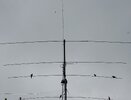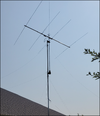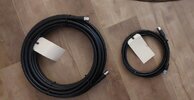If I can ever escape this HOA and get to a property that I can install a base antenna I'm going to run my coax through some cheap PVC pipe. More expense, but hopefully fewer surprises from tree rats.Sure enough, the fekkin squirrels have been gnawing on the coax at multiple spots.
You are using an out of date browser. It may not display this or other websites correctly.
You should upgrade or use an alternative browser.
You should upgrade or use an alternative browser.
-
You can now help support WorldwideDX when you shop on Amazon at no additional cost to you! Simply follow this Shop on Amazon link first and a portion of any purchase is sent to WorldwideDX to help with site costs.
-
A Winner has been selected for the 2025 Radioddity Cyber Monday giveaway! Click Here to see who won!
M104C Project
- Thread starter TimmyTheTorch
- Start date
Yet another reason why i recommend hardline. U
It is a neglige cost difference that pays enormous dividends far less loss, better connectors, squirrel proof. You could use 1/4 hardline if you wanted.
To put it in comparison, belden rg213 is 1.35 a foot, i bought ldf4-50a for a whooping 1.65 a foot ... Its a no brainer.
Rg213 loses 30% of its power on a 100ft run . 1/2" hard line loses something like 8%. It literally gives you back free watts.
It is a neglige cost difference that pays enormous dividends far less loss, better connectors, squirrel proof. You could use 1/4 hardline if you wanted.
To put it in comparison, belden rg213 is 1.35 a foot, i bought ldf4-50a for a whooping 1.65 a foot ... Its a no brainer.
Rg213 loses 30% of its power on a 100ft run . 1/2" hard line loses something like 8%. It literally gives you back free watts.
Not trying to hijack the thread, but where does a person get hard line and connectors?Yet another reason why i recommend hardline. U
It is a neglige cost difference that pays enormous dividends far less loss, better connectors, squirrel proof. You could use 1/4 hardline if you wanted.
To put it in comparison, belden rg213 is 1.35 a foot, i bought ldf4-50a for a whooping 1.65 a foot ... Its a no brainer.
Rg213 loses 30% of its power on a 100ft run . 1/2" hard line loses something like 8%. It literally gives you back free watts.
Rfparts, eBay, anywhere.Not trying to hijack the thread, but where does a person get hard line and connectors?
I got the coax entirely off the ground, cleaned out the spots where the casing had been chewed through, covered them with liquid tape and then after that dried, covered the spots with Temflex rubber splicing tape. So far, so good with the RF problem being fixed. I was able to make several contacts to England, Ireland, California and Florida and had great sound on the monitoring radio too.
So it looks like having a section of coax lying on the ground with exposed shielding in contact with the ground messes up the works a bit. Or it's just a coincidence that the problem went away after fixing the coax casing. I did not make any other changes.
I did end up ordering two new 50 foot RG213 coax to replace this patched coax before winter.
But before I do that, I need to weld up a removable joint brace to put where the first 11' section of mast joins the second 11' section. It is already internally reinforced but when I was raising the setup, I was not comfortable with how much it still gave. So time for an external brace made from two 2" wide by 1/4" thick pieces of 48 inch long steel angle iron. I am going to weld on multiple tabs on each one and drill a hole in each so I can use grade 8 bolts to basically have the mast as the hot dog and the angle iron as the bun surrounding and supporting the joint. Plus I haven't been able to play with the welder for a while, so that's a factor too!
So it looks like having a section of coax lying on the ground with exposed shielding in contact with the ground messes up the works a bit. Or it's just a coincidence that the problem went away after fixing the coax casing. I did not make any other changes.
I did end up ordering two new 50 foot RG213 coax to replace this patched coax before winter.
But before I do that, I need to weld up a removable joint brace to put where the first 11' section of mast joins the second 11' section. It is already internally reinforced but when I was raising the setup, I was not comfortable with how much it still gave. So time for an external brace made from two 2" wide by 1/4" thick pieces of 48 inch long steel angle iron. I am going to weld on multiple tabs on each one and drill a hole in each so I can use grade 8 bolts to basically have the mast as the hot dog and the angle iron as the bun surrounding and supporting the joint. Plus I haven't been able to play with the welder for a while, so that's a factor too!
My horizontal M104C and V58 with no ground plane radials installed is still up and surviving. I think the 7 guy wires do a good job of covering the angles. The Yaesu G-800DXA rotor is working well too. The horizontal M104C gets the job done but I find I rarely use the V58 and there are some locals (20-30 miles) here where I would really like to have a vertical beam to pick them up better. The V58 picks up too much noise to the east (90 degrees from where the locals are located from me) and the horizontal M104C doesn't get along well with these local stations.
Looking at the assembly instructions for the Maco Shooting Star (4 horizontal, 4 vertical elements and a reflecting wire), it seems like I should be able to grab some suitable aluminum tubing to use for the vertical elements, a gamma match, some fiberglass rods and wire for the reflector and basically turn my M104C into a Shooting Star and forego installing the V58 on this same mast. I may find another part of the property to stick up the V58 if I decided to do so in the future. I have a feeling that once I start adding up the cost for the individual bits needed to do this, it'd be more money that just buying a brand new Shooting Star.
Or maybe I can keep an eye out for someone selling a used M104C, or a Moonraker IV in someone's attic or a Shooting Star that's looking for a new home. Or maybe just leave it all alone. But that's really not like me at all. I do love to futz about and experiment.
The birds are still hanging out of the elements. Good thing we don't have any hefty birds making themselves at home on them.

Looking at the assembly instructions for the Maco Shooting Star (4 horizontal, 4 vertical elements and a reflecting wire), it seems like I should be able to grab some suitable aluminum tubing to use for the vertical elements, a gamma match, some fiberglass rods and wire for the reflector and basically turn my M104C into a Shooting Star and forego installing the V58 on this same mast. I may find another part of the property to stick up the V58 if I decided to do so in the future. I have a feeling that once I start adding up the cost for the individual bits needed to do this, it'd be more money that just buying a brand new Shooting Star.
Or maybe I can keep an eye out for someone selling a used M104C, or a Moonraker IV in someone's attic or a Shooting Star that's looking for a new home. Or maybe just leave it all alone. But that's really not like me at all. I do love to futz about and experiment.
The birds are still hanging out of the elements. Good thing we don't have any hefty birds making themselves at home on them.

Last edited:
looks wonderfull well done !
Looking forward to hear about your progress !
Looking forward to hear about your progress !
I mean yes the cheapest thing to do would be to get some tubing get some hardware get another gamma match and make it into a 4 + 4. On the other hand by the time you take the antenna down and do all the work and source all the parts yes it'll be cheaper but you could probably just take your antenna down sell it and buy a four plus four and throw it up in a couple hours and do a lot less work
I got out my protractor, slide rule and pocket protector and did some calculations. Looks like either putting up a Shoot Star or adding four vertical elements to my existing M104C is going to have an interference issue with the upper guy wires. I can lower the top set of them some, but I don't want to do it at the risk of the whole thing blowing over. It's very sturdy as it is now and has withstood 70 mph winds and two Wisconsin winters so far.
And replacing this with a tower is problematic on several fronts. Other than money, the biggest one is that we have a lot of very nice large trees on our property and they really restrict my ability to have a tower we can stand up. Probably limited to 30 feet, so not worth it to me. Of course, there are crank-up towers but wow are they $$$$.
This picture was taken right before we took up the slack in the guy wires.

And replacing this with a tower is problematic on several fronts. Other than money, the biggest one is that we have a lot of very nice large trees on our property and they really restrict my ability to have a tower we can stand up. Probably limited to 30 feet, so not worth it to me. Of course, there are crank-up towers but wow are they $$$$.
This picture was taken right before we took up the slack in the guy wires.

I'm again reconsidering converting the M104C into a Shooting Star either by adding the vertical elements to the existing boom or by buying one. The total weight and wind load of the horizontal M104C and V5/8 up there now is quite close to that of the Shooting Star so I don't think my rotor will have trouble handling it. Maybe I'll get lucky and find someone wanting to sell either a M104C I can use for parts or an entire Shooting Star. If it turns out to be too expensive, I'll just stick with what I have now. It's not like the bands are exactly alive with action, but part of wanting a stronger vertical signal is due to the lack of propagation. It'd be nice to talk to "locals" that are a fair distance away.
I plan on doing some testing with guy wires at various heights to see exactly what I can do based on the length of the vertical elements, the guy wire connection points on the mast and location of the guy wire bases.
I know it's much less than ideal to have a vertical element near the mast but I think/hope the performance of the 4 element vertical would still beat that of the V5/8 by a considerable margin. I have no evidence to back that up, just my thought. Not very sciencey though.
I plan on doing some testing with guy wires at various heights to see exactly what I can do based on the length of the vertical elements, the guy wire connection points on the mast and location of the guy wire bases.
I know it's much less than ideal to have a vertical element near the mast but I think/hope the performance of the 4 element vertical would still beat that of the V5/8 by a considerable margin. I have no evidence to back that up, just my thought. Not very sciencey though.
If you put vertical elements on the mast of your current beam, you should take off the 5/8 vertical as you won't need it. Remember, it's the feedpoint height of the vertical antenna (and all antennas) that matters not the overall height of the antenna. You'll have both a 4 element horizontal and 4 element vertical beam with a Shooting star which will far outperform that 5/8 vertical.I'm again reconsidering converting the M104C into a Shooting Star either by adding the vertical elements to the existing boom or by buying one. The total weight and wind load of the horizontal M104C and V5/8 up there now is quite close to that of the Shooting Star so I don't think my rotor will have trouble handling it. Maybe I'll get lucky and find someone wanting to sell either a M104C I can use for parts or an entire Shooting Star. If it turns out to be too expensive, I'll just stick with what I have now. It's not like the bands are exactly alive with action, but part of wanting a stronger vertical signal is due to the lack of propagation. It'd be nice to talk to "locals" that are a fair distance away.
I plan on doing some testing with guy wires at various heights to see exactly what I can do based on the length of the vertical elements, the guy wire connection points on the mast and location of the guy wire bases.
I know it's much less than ideal to have a vertical element near the mast but I think/hope the performance of the 4 element vertical would still beat that of the V5/8 by a considerable margin. I have no evidence to back that up, just my thought. Not very sciencey though.
I would keep your 4 element and get another one and modify the reflector to make it into a Shooting star version because they both use the same boom length.
However, the original Shooting star antenna uses fiberglass rods as a wire support for the reflector. You seem like a handyman that can figure out something to use.
Once you figure that out I think you can easily just drill a small hole and use a self tapping screw and washer at the end of each element to secure it.
Download the Shooting star manual and I believe you can figure out.
Good luck!
Not really much of a hijack, This is worth noting for all reading this thread. The OP did post some pics of the rotor platforms he used that I thought were interesting and I ended up getting a set for my antenna mast because of this thread.Not trying to hijack the thread, but where does a person get hard line and connectors?
I'll do the same here and offer a suggestion!
If you are still looking for Hardline, The Antenna Farm has it and they can install connectors for you as an option when you order custom lengths. For 1/2 inch hardline, the connectors are pricey and the proper tools are too plus you need some experience doing it. It was well worth it to have them install it for me since I will only do this once.
I purchased 70 ft of 1/2 inch Heliax hardline with N connectors for my setup to go from my Beam to a ground rod mounted polyphaser just outside of my shack. Then I used 15 ft of 3/8 inch superflex Heliax to go from the polyphaser to inside my shack. This superflex is easy to work with. I could have went with 1/4 inch.
You could go with 1/2 inch superflex if you need something easier to work with cause the hardline is a bit of a chore to lay it out plus you don't want to do repeated bends. With the hardline, just lay it out and install it and leave it! The spec's on the superflex is slightly higher on dB loss but not much.
This type of coax maybe an overkill for many setups but I have good money spent in my radio's and beam antenna so why not go with the best? The attenuation loss on 1/2 inch HL on 30Mhz @100 ft is .357dB and even lower at 27 Mhz which is practically nothing and even less at lengths under a 100ft.
Total cost for 70ft of 1/2 HL and 15 ft of 3/8 SPF with four N connectors installed plus $70 shipping was $380 back in 2023.
Depending on your needs and if you are confident about installing the connectors yourself, going with Heliax can be one and a half times or a bit more the cost of RG 213 or LMR 400. I have no regrets!
1/2 Heliax Hardline - Custom Made Coax Cable Assemblies

Last edited:
